
Ashton Court is a mansion house and estate to the west of Bristol in England. Although the estate lies mainly in North Somerset, it is owned by the City of Bristol. The mansion and stables are a Grade I listed building. Other structures on the estate are also listed.
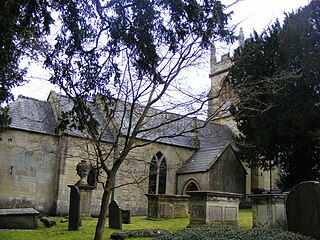
Combe Hay is a village and civil parish in the English county of Somerset. It falls within the Cotswolds Area of Outstanding Natural Beauty. The parish has a population of 147.

Prior Park is a Neo-Palladian house that was designed by John Wood, the Elder, and built in the 1730s and 1740s for Ralph Allen on a hill overlooking Bath, Somerset, England. It has been designated as a Grade I listed building.

The Somerset Coal Canal was a narrow canal in England, built around 1800. Its route began in basins at Paulton and Timsbury, ran to nearby Camerton, over two aqueducts at Dunkerton, through a tunnel at Combe Hay, then via Midford and Monkton Combe to Limpley Stoke where it joined the Kennet and Avon Canal. This link gave the Somerset coalfield access east toward London. The longest arm was 10.6 miles (17.1 km) long with 23 locks. From Midford an arm also ran via Writhlington to Radstock, with a tunnel at Wellow.
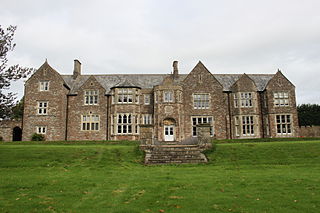
Sutton Court is an English house remodelled by Thomas Henry Wyatt in the 1850s from a manor house built in the 15th and 16th centuries around a 14th-century fortified pele tower and surrounding buildings. The house has been designated as Grade II* listed building.

The Royal United Hospital (RUH) is a major acute-care hospital in the Weston suburb of Bath, England, which lies approximately 1.5 miles (2.4 km) west of the city centre. The hospital has 565 beds and occupies a 52 acres (21 ha) site. It is the area's major accident and emergency hospital, with a helicopter landing point on the adjacent Lansdown Cricket Club field. The hospital is operated by the Royal United Hospitals Bath NHS Foundation Trust.
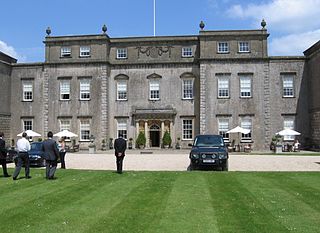
Ston Easton Park is an English country house built in the 18th century. It lies near the village of Ston Easton, Somerset. It is a Grade I listed building and the grounds are listed Grade II on the Register of Historic Parks and Gardens.
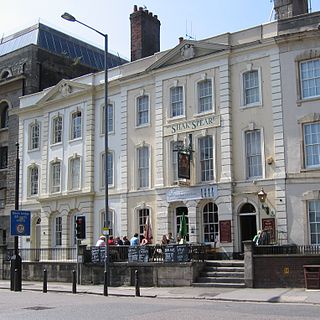
The Shakespeare is an historic pub in Prince Street, Bristol, England. Built in 1725 by the Bristol builder John Strahan as a pair of attached Georgian-style houses, it was converted into a pub in 1777 at which time it supplied refreshment to dock workers at the adjoining port. It has been a grade II* listed building since 1959.
Babington is a small village between Radstock and Frome, Somerset, England, which has now largely disappeared.
Combe Florey House in Combe Florey, Somerset, England is a country house dating from the early 18th century. It replaced an Elizabethan manor house which was pulled down after the English Civil War. The gatehouse to the original manor survives. In the mid-20th century, the house was home to the writer Evelyn Waugh who died there in 1966 and is buried next to the churchyard of the adjacent Church of St Peter & St Paul. Combe Florey House is a Grade II listed building.

Leigh Court is a country house which is a Grade II* listed building in Abbots Leigh, Somerset, England. The grounds and park are listed, Grade II, on the Register of Historic Parks and Gardens of special historic interest in England.
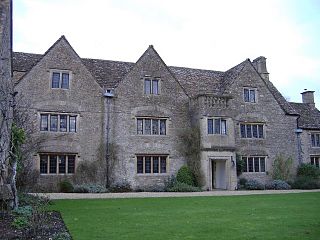
Bolehyde Manor is a 17th-century manor house at Allington, north-west of Chippenham, in Wiltshire, England. It is a Grade II* listed building within the Allington conservation area of Chippenham Without parish. Camilla Parker Bowles lived at the house between 1973 and 1986, during her first marriage.

Earnshill House in Hambridge, near Curry Rivel, Somerset, England is a manor house, set in parkland. It was built in 1725 for Henry Combe, a Bristol merchant by John Strachan. It has been designated as a Grade I listed building.
John Strahan was an architect working in Bristol and Bath, England in the early 18th century. He died around 1740.

Camerton Court is a historic house in the village of Camerton, Somerset, England. It has been designated as a Grade II listed building.

Kelston Park is an 18th-century country house in the village of Kelston, approximately 3 miles from Bath in North East Somerset, England. Altogether the house and gardens of Kelston Park cover an area of approximately 75 hectares. The house has been designated as a Grade II* listed building, and the garden is Grade II* listed in the National Register of Historic Parks and Gardens.

Hutton Court is a country house at Hutton, Somerset, England, built in the 15th century as a manor house. It is Grade II* listed on the National Heritage List for England. In addition to the main house, the boundary wall, summerhouse and the gates and piers to the hall are all separately Grade II listed. and stands immediately to the south of the parish church.
The Manor House in Chew Magna, Somerset, England, was a country house built in the middle of the 17th century. It was the principal residence of the Adlam family from the mid-1800s until 1940. The house is a Grade II* listed building and formed part of the Sacred Heart Convent School. It has now been redeveloped and returned to residential use.

Woolston Manor was an estate that covered about 230 acres (93 ha) in Somerset, England. It included arable land and pasturage, worked by a tenant farmer. The lands were later sold as a farm. The Woolston Manor Farmhouse is a large stone house completed in 1838 that replaced the earlier manor house. It is now a Grade II listed building.

The Combe Hay Locks is a derelict flight of locks on the Somerset Coal Canal near Combe Hay, Somerset, England. Twenty two locks raised the canal 134 feet (41 m) over approximately 1.6 miles (2.6 km). The lock flight was predated in the immediate area by two other methods of canal lifts—first by a series of caisson locks, then by an inclined plane. The lock flight opened in 1805, and was in operation until 1899.

















